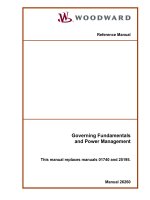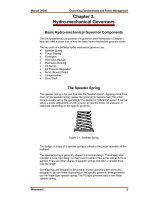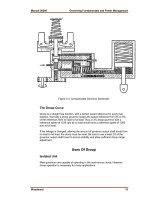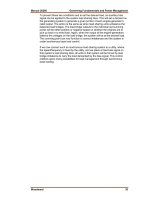Governing Fundamentals and Power Management phần 1 ppt
Bạn đang xem bản rút gọn của tài liệu. Xem và tải ngay bản đầy đủ của tài liệu tại đây (159.7 KB, 10 trang )
Reference Manual
Governing Fundamentals
and Power Management
This manual replaces manuals 01740 and 25195.
Manual 26260
Woodward Governor Company reserves the right to update any portion of this publication at any time. Information
provided by Woodward Governor Company is believed to be correct and reliable. However, no responsibility is
assumed by Woodward Governor Company unless otherwise expressly undertaken.
© Woodward 2004
All Rights Reserved
Manual 26260 Governing Fundamentals and Power Management
Woodward i
Contents
CHAPTER 1. INTRODUCTION TO GOVERNING 1
Introduction 1
Other References 1
What is a Governor? 1
Governor Components 3
Development of the Modern Governor System 4
CHAPTER 2. HYDRO-MECHANICAL GOVERNORS 5
Basic Hydro-mechanical Governor Components 5
The Speeder Spring 5
Thrust Bearing 6
Flyweights 6
Pilot Valve Plunger and Bushing 8
Oil Pumps 9
Direction of Rotation 10
The Servo (Power) Piston 11
CHAPTER 3. DROOP 13
Introduction 13
Why Is Droop Necessary? 13
Speed Droop Operation 14
Uses Of Droop 15
Isolated Systems 18
CHAPTER 4. LINKAGE 22
General 22
Governor Travel 23
Linear Linkage Arrangements 24
Non-Linear Usage 25
CHAPTER 5. MAGNETIC PICKUPS 26
Introduction 26
CHAPTER 6. LOAD SENSING, LOAD SHARING, BASE LOADING 30
Load Sensing 30
Load Gain Adjust Potentiometer 30
Balanced Load Bridge 31
Power Output Sensor 34
Isochronous Base Load 34
CHAPTER 7. SYNCHRONIZATION 39
What Is Synchronization? 39
Why Is Synchronization Important? 42
How Is Synchronization Accomplished? 42
Prediction of the Worst Case Phase Angle Difference (φ) at the Instant of
Breaker Closure 44
Governing Fundamentals and Power Management Manual 26260
ii Woodward
Contents
CHAPTER 8. MANAGING POWER FOR THE DESIRED RESULT 46
Peaking or Peak Load Control 46
Cogeneration 51
Single Engine AGLC–Base Load Control 51
Isolated Bus Isochronous Load Sharing System 57
Multiple Engine AGLC–Base Load Control 60
Automatic Paralleling System (2301A) to a Utility Using a Process-Import/Export
Control 63
Automatic Paralleling System (2301A) to a Utility Using an Automatic Power
Transfer And Load (APTL) Control 66
Illustrations and Tables
Figure 1-1. The Driver is the Governor 2
Figure 1-2. Speed Balance 2
Figure 2-1. Speeder Spring 5
Figure 2-2. Speeder Spring Deflection 6
Figure 2-3. Hydraulic Governor Ballhead 6
Figure 2-4. Flyweight Action 7
Figure 2-5. Flyweights to Minimize Friction 7
Figure 2-6. Pilot Valve Operation Shown “On Speed” 8
Figure 2-7. Oil Pumps 9
Figure 2-8. Accumulator and Governor Relief Valve 10
Figure 2-9. Pump Rotation 10
Figure 2-10. Spring Loaded Servo Piston 11
Figure 2-11. Differential Power Piston 12
Figure 3-1. Response Curves of Governor without Droop or Compensation 13
Figure 3-2. Droop Feedback 14
Figure 3-3. Compensated Governor Schematic 15
Figure 3-4. Comparison of 3% Droop Speed Settings for 50% and 100% Load .16
Figure 3-5. 3% and 5% Droop Curves 16
Figure 3-6. Droop Mode 17
Figure 3-7. Swing Machine 18
Figure 3-8. Droop Units 19
Figure 3-9. Base Load with 5% Droop 20
Figure 3-10. Schematic of Droop Governor 21
Figure 4-1. Linear Fuel Control 22
Figure 4-2. Non-Linear Fuel Control 23
Figure 4-3. Correct Use of Governor Travel 23
Figure 4-4. Nonlinear Carburetor Linkage 25
Figure 5-1. Magnetic Pickup 26
Figure 5-2. Low Reluctance Gear Position 27
Figure 5-3. High Reluctance Gear Position 27
Figure 5-4. Magnetic Pickup and Gear Dimensions 28
Figure 5-5. Generated Waveforms 29
Figure 6-1. Generator Load Sensor 30
Figure 6-2. Balanced Load Bridge 31
Figure 6-3. Basic Load Sensing Block Diagram 32
Manual 26260 Governing Fundamentals and Power Management
Woodward iii
Illustrations and Tables
Figure 6-4. Load Sharing Diagram 36
Figure 6-5. Load Sharing Block Diagram 37
Figure 6-6. Multiple Load Sharing Block Diagram 38
Figure 7-1. Number of Phases Must Match Number Of Phases 39
Figure 7-2. Phase Rotation Must be the Same Rotation Of Phases 40
Figure 7-3. Voltage Difference (Generator to Generator) 40
Figure 7-4. Voltage Difference (Generator to Bus) 40
Figure 7-5. Frequency Difference 41
Figure 7-6. Phase Difference 41
Figure 7-7. Checking Phase Match 43
Figure 7-8. Checking Phase Rotation and Match 43
Figure 7-9. Phase Angle Relationship 45
Figure 8-1. "Peaking" or Peak Load Control 47
Figure 8-2. Base Loading 48
Figure 8-3. Peak Shaving 48
Figure 8-4. Import Power 49
Figure 8-5. Import Power (Constant Level) 49
Figure 8-6. Export Power 49
Figure 8-7. Export Power (Constant Level) 50
Figure 8-8. Import/Export Control 50
Figure 8-9. Zero Import/Export 50
Figure 8-10. Synchronizing to Utility or Plant Bus 53
Figure 8-11. Synchronizing Gen Set to Plant Bus or to Utility 54
Figure 8-12. Single Engine AGLC Base Load 55
Figure 8-13. Connections for Single Engine AGLC Base Load System 56
Figure 8-14. Using AGLC for Soft Load, Soft Unload, and Base Load to an
Isolated Bus for Isochronous Load Sharing 58
Figure 8-15. Connections Used with AGLC for Soft Loading, Unloading, and
Base Loading with Isochronous Load Sharing Against an Isolated
Bus 59
Figure 8-16. Using the AGLC to Base Load Multiple Engines to a Utility 61
Figure 8-17. Connecting an AGLC to Base Load Multiple Engines to a Utility 62
Figure 8-18. Using Process-Import/Export Control to Automatically Parallel 64
Figure 8-19. Connecting Process-Import/Export Control to Paralleling System 65
Figure 8-20. Using APTL in Automatic Paralleling System 67
Figure 8-21. Connecting APTL in Automatic Paralleling System 68
Governing Fundamentals and Power Management Manual 26260
iv Woodward
Manual 26260 Governing Fundamentals and Power Management
Woodward 1
Chapter 1.
Introduction to Governing
Introduction
This manual combines former Woodward manuals 25195 (Governing
Fundamentals) and 01740 (Power Management). Chapters 1–5 cover basic
governing, and chapters 6–9 cover the principles of power management.
Other References
Other useful references you might find useful can be found on our website
(www.woodward.com):
Pub. No. Title
25075A Commercial Preservation Packaging for Storage of Mechanical-Hydraulic
Controls
25070D Electronic Control Installation Guide
25014C Gas Engine Governing
25179C Glossary of Control Names
50516 Governor Linkage for Butterfly Throttle Valves
82715H Guide for Handling and Protection: Electronic Controls, PCBs, Modules
82510M Magnetic Pickups and Proximity Switches for Electronic Controls
25071J Oils for Hydraulic Controls
83402 PID Control
83408 PLCs for Turbine Control Systems
50511A Prediction of Phase Angle at Breaker Closure
50500D Simplified Unloading Scheme for Electric Governors
01302 Speed Droop & Power Generation
51214 Work versus Torque
In addition, all product specifications, brochures, catalogs, and application notes
(as well as many technical manuals) can be found on the website.
What is a Governor?
All power sources must be controlled in order to convert the power to useful
work. The essential device which controls the speed or power output of an
engine, turbine, or other source of power is called a governor. For simplicity,
we’ll call the source of power a prime mover.
A governor senses the speed (or load) of a prime mover and controls the fuel (or
steam) to the prime mover to maintain its speed (or load) at a desired level. In
some cases the governor controls other factors that determine the speed or load
of the prime mover. In all cases, a governor ends up controlling the energy
source to a prime mover to control its power so it can be used for a
specific purpose.
Governing Fundamentals and Power Management Manual 26260
2 Woodward
Example—If you’ve ever driven a car, you’ve functioned as a governor when you
control the car’s speed under varying driving conditions.
Figure 1-1. The Driver is the Governor
The driver (governor) adjusts the fuel to maintain a desired speed. If the speed
limit is 100 (this is the desired speed), you check the speedometer (the car’s
actual speed). If actual speed and desired speed are the same, you hold the
throttle steady. If not equal, you increase or decrease throttle position to make
the desired speed and the actual speed the same (see Figure 1-2).
As the car starts uphill, the load increases and actual speed decreases. The
driver notes that actual speed is less than desired speed and moves the throttle
to increase speed back to the desired speed at the increased load.
As the car goes downhill, the load decreases and actual speed increases. The
driver notes that actual speed is greater than desired speed and decrease the
throttle to return to the desired speed with the decreased load.
Figure 1-2. Speed Balance
Manual 26260 Governing Fundamentals and Power Management
Woodward 3
If your car has a cruise control, the cruise control is a simple governor.
Governor Components
All governors have five fundamental components:
• A way to set the desired speed. (The driver sets the desired speed
mentally.)
• A way to sense actual speed. (The driver refers to the speedometer).
• A way to compare the actual speed to the desired speed. (The driver
compares the two items mentally.)
• A way for the governor to change the fuel to the prime mover (moving the
rack or fuel valve). (The driver moves the throttle.)
• A way to stabilize the engine after a fuel change has been made.
In the example, when the car went up a hill, the driver saw the actual speed
decrease and moved the throttle to increase the fuel. You will need to increase
the fuel an amount to cause the speed to increase. This will give the engine
enough power to make the car return to the desired speed with a bigger load. As
you see that the actual speed is about to reach the desired speed, you reduce
the extra fuel to the exact amount needed to match (balance) the desired speed
with the actual speed. The governor does the same thing, using feedback. This
feedback closes the loop in the control system which controls the amount of
fuel change, based on the rate the desired speed is being reached. This prevents
large overshoots or undershoots of speed which is known as hunting, and
stabilizes the engine. The opposite is true when the car goes down the hill or
load is reduced.
1. Speed Setting
Setting the “desired speed” of a governor is necessary to efficiently control
prime movers. Modern governors have advanced systems of speed setting
which can compensate for a variety of conditions when determining the
desired speed. Hydro-mechanical governors use what is known as a
speeder spring. The more force applied to this spring, the higher the desired
speed setting is. Electronic controls use an electronic force (voltage and
current) to set speed. The more the force is increased, the more the output
to the fuel increases.
Speed setting and the effect on sharing loads between engines will be
discussed in other chapters.
2. Sensing Speed
The governor must receive a force that is proportional to the speed of a
prime mover. In hydro-mechanical governors, it is done by the centrifugal
force of flyweights being rotated from a drive system that is connected to the
prime mover, and is directly related to the speed of the prime mover. In
electronic controls, this force comes from sensing of the frequency of a
magnetic pickup, alternator, or generator which is directly related to the
speed of the prime mover. The frequency is then changed to an electronic
force that the control can use. In both cases, the faster the engine runs, the
stronger the speed sensing force becomes.
Governing Fundamentals and Power Management Manual 26260
4 Woodward
3. Comparing the “Actual Speed” to the “Desired Speed”
The force of the “desired speed setting” and the force of the “actual speed”
are compared or “summed” together. “Desired speed setting” is a force in
one direction and “actual speed” is a force in the opposite direction. When
these opposing forces are the same value, their sum will be zero and at that
point the governor is controlling actual speed at the point of the desired
speed setting. If the “desired speed setting” force is stronger than the
“actual speed” force, the governor will increase fuel. If the “actual speed”
force is stronger than the “desired speed setting” force, the governor will
decrease fuel. As fuel is increased or decreased, these forces will change
until they balance or “sum to zero.” In hydro-mechanical governors, these
forces are summed at the “thrust bearing”. In electronic controls, these
forces are summed at what is known as a “summing point.” Note that other
forces can be applied along with these forces to allow the governor to be
stabilized and perform other functions (some of these are covered in later
chapters). Remember that all forces applied to the “thrust bearing” or
“summing point” must algebraically sum up to zero for the governor to
control fuel at a steady state.
4. Ways for the Governor to Change Fuel to the Prime Mover
The hydro-mechanical governor or actuator normally has a rotational or
linear output shaft that is connected to the prime mover‘s fuel system. When
the governor needs to make a fuel correction to maintain speed (or load),
the output shaft moves in the proper direction to correct the final fuel setting.
For electronic controls, an electrical signal is sent to an actuator which
converts this electrical signal to a mechanical force to move the fuel setting
in the same way the hydro-mechanical governors do. Different types of
governors and actuators have different amounts of work output to meet the
control needs of various prime movers.
5. Ways to Stabilize the Prime Mover
Stabilization is accomplished through a variety of ways, but all of them use a
“feedback” system to apply a force to the “thrust bearing” or “summing
point.” This “feedback” is normally in the form of either droop or
compensation, or in a combination of both. Droop or compensation is
usually related to the amount the output shaft is told to move (Chapter 3
describes the essential principle of droop feedback).
Note that in many prime mover systems (such as power generation), the speed
of the prime mover is fixed. While the governor still controls the prime mover’s
speed setting mechanism, the end result of changes in the prime mover’s speed
setting under fixed-speed conditions is that an increase or decrease in the speed
setting causes the prime mover to take on a larger or smaller load.
Development of the Modern Governor System
The first modern governors were applied to controlling the speed and load of
water wheels (which were used to power many of the early factories during the
“Industrial Revolution”. Early governors also controlled steam turbines. The
development of gasoline and diesel internal combustion engines required faster
and more complex governors. Electrical power generation created a much
greater need for more precise governor control of speed and load.
Hydro-mechanical governors became ever more complex to meet growing needs
for precise control. Since the 1970s, electronic controls have significantly
improved and expanded the capabilities of governing systems, controlling not
only speed and load, but also electrical loads, exhaust emissions, and many
other parameters.









